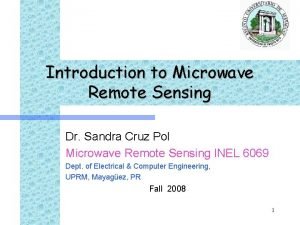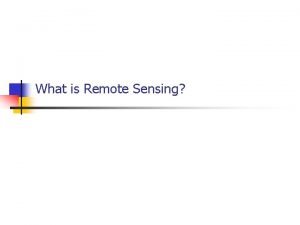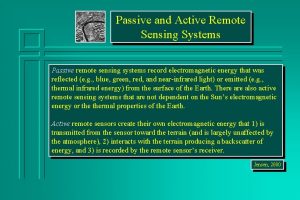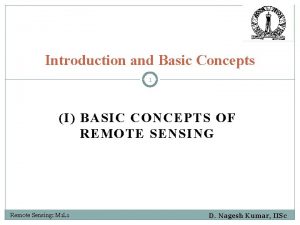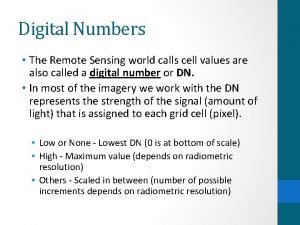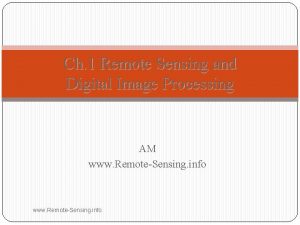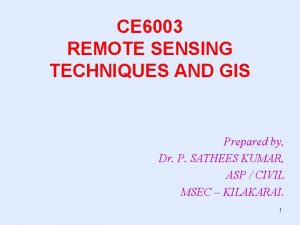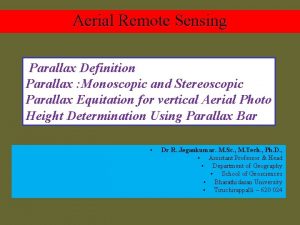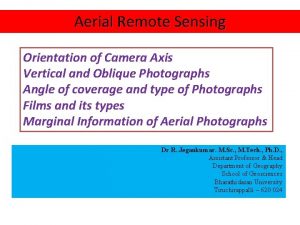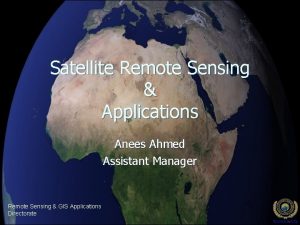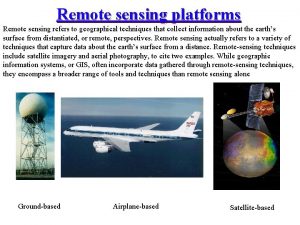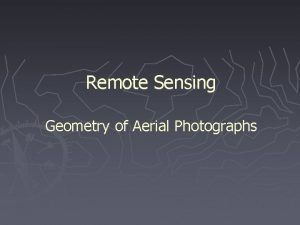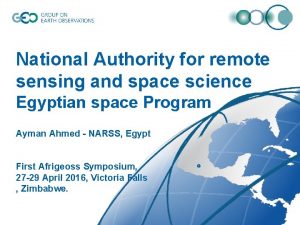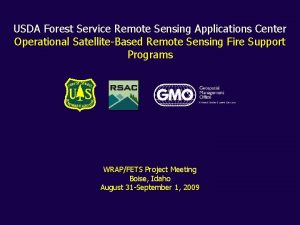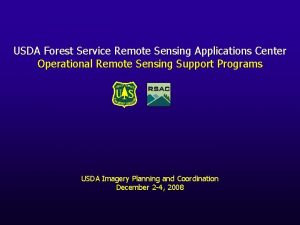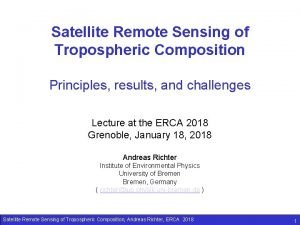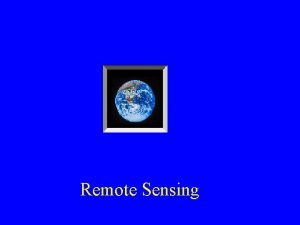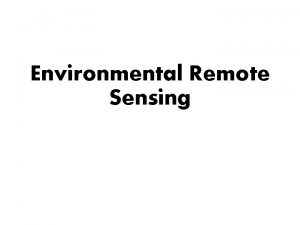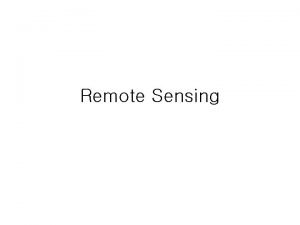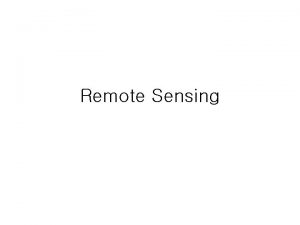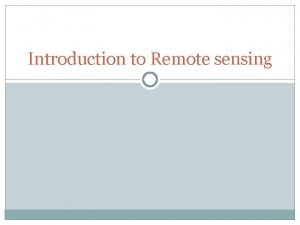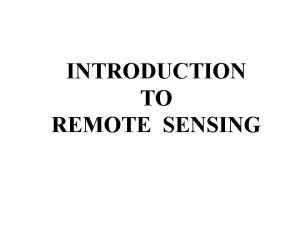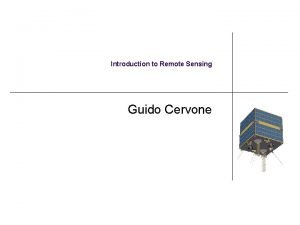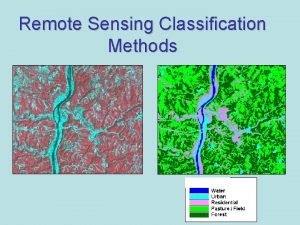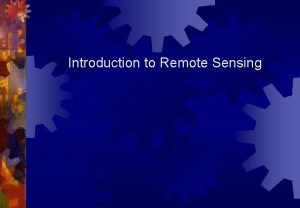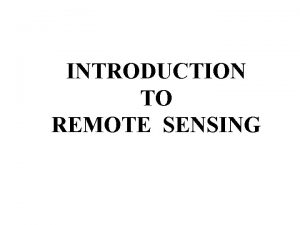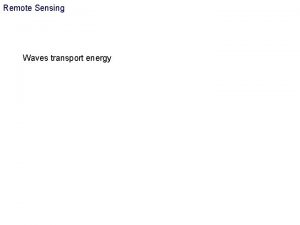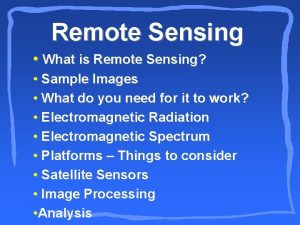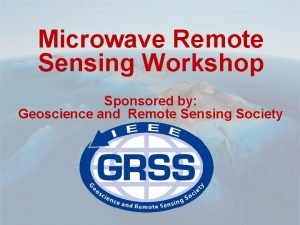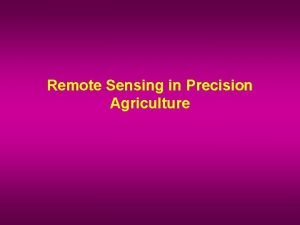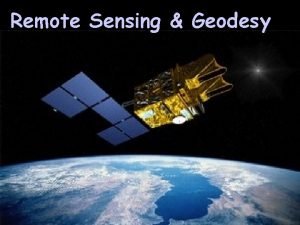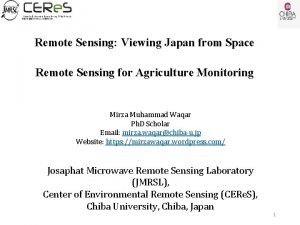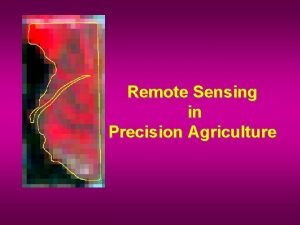Chapter 5 Field Data Introduction to Remote Sensing





















- Slides: 21

Chapter 5 Field Data Introduction to Remote Sensing Instructor: Dr. Cheng-Chien Liu Department of Earth Sciences National Cheng Kung University Last updated: 27 October 2004

Outline § Introduction § Information of field data § Field radiometry § Tutorial/demonstration of handheld spectroradiometer § Basic radiometric quantities and definitions § Location information § Tutorial/demonstration of handheld GPS § Geographic sampling

Introduction § Field data • Necessary for remote sensing v. Establish relationship between ground truth and imagery v. Validation v. Evaluation • Expensive • Purpose-oriented v. Content v. Method

Information of field data § Attributes/measurements of ground conditions • Nominal data ve. g. crop identification, land use, … • Biophysical data v. Moisture content, Leaf area index (LAI), … • Radiometry data § Location and size § Time and date § Ancillary data • Weather, illumination, calibration of instrument, persons who collect data

Field radiometry § Handheld spectroradiometer • Constitution (Fig 1. 14 a or see Campbell 2002 Fig 124) v. Pointing device v. Fiber-optical cable v. Measuring unit Ø Detector Ø Filter v. Display unit v. Data log • Measurement v. Radiance v. Reflectance

Tutorial/demonstration of handheld spectroradiometer § Software installation § Hardware installation § Calibration § Data log § Data processing § Implementation • (Fig 1. 14 b and Fig 1. 15, or see Campbell 2002 Fig 12 -9)

Basic radiometric quantities and definitions § § § § § Spherical coordinate Measurement of radiance L Definition of L Measurement of planar irradiance E Definition of E Measurement of scalar irradiance E 0 Definition of reflectance R = Eu/Ed Definition of remote sensing reflectance Rrs =Lu/Ed

Locational information § Observations need locational information § Method • Reference to distinctive landmarks v. Valid for well-mapped regions • Global Positioning System (GPS)

Global Positioning System § Satellite § Orbit § Working principle § Receiver § Accuracy • Selective availability (SA)

Geographic sampling § Terminology • Observation • Sample § Three considerations • Number of observations • Sampling pattern • Spacing of observations

Geographic sampling (cont. ) § Number of observations • The larger the sample size, the closer to the actual values • Minimum number assigned to each class § Sampling pattern • • • Simple random sampling pattern Stratified random pattern Systematic patterns Systematic stratified unaligned pattern Cluster sampling § Spacing of observations

Homework § We are going to employ the handheld spectroradiometer and GPS receiver to collect field data of vegetation in the watershed of Chen-Yo-Lan River. Please help us to integrate these instruments on (1) Shoulder (2) Suzuki grand Vitara (3) unmanned helicopter

Homework (cont. ) § The reflectance of a standard white board is given in Table 1. The field measurements of the standard white board and the sample are shown in Table 2, respectively. Please use this information to calculate the reflectance of the sample. Table 1 Table 2 Wavelength (nm) 400 450 500 550 600 650 700 Reflectance 0. 455 0. 458 0. 461 0. 464 0. 467 0. 471 Wavelength (nm) 400. 26 450. 33 500 550. 23 600. 21 650. 19 700. 04 White board 352. 265 838. 265 2607. 952 2902. 265 2397. 952 1751. 952 1015. 265 Sample 12. 934 29. 934 84. 929 254. 934 124. 929 56. 929 91. 934

Source

Fig 2. 3. 1 Fig. 2. 3. 1 Definition of the polar coordinates (q, f) and of the upward (Xu) and downward (Xd) hemispheres of directions. Reprint from Figure 1. 3 in (Mobley 1994).

Fig. 2. 3. 2 Schematic design of an instrument for measuring un-polarized spectral radiance. Reprint from Figure 1. 5 in (Mobley 1994).

2. 3 Basic radiometric quantities and definitions (cont. ) § Radiance L:

Fig. 2. 3. 3 Schematic design of an instrument for measuring un-polarized spectral downwelling planar irradiance. Reprint from Figure 1. 6 in (Mobley 1994).

2. 3 Basic radiometric quantities and definitions (cont. ) § Downwelling planar irradiance Ed:

Fig. 2. 3. 4 Schematic design of an instrument for measuring un-polarized spectral downwelling scalar irradiance. Reprint from Figure 1. 7 in (Mobley 1994).

2. 3 Basic radiometric quantities and definitions (cont. ) § Downwelling scalar irradiance E 0 d:
 Introduction to microwave remote sensing
Introduction to microwave remote sensing Energy transfer
Energy transfer Remote sensing platforms
Remote sensing platforms Active vs passive remote sensing
Active vs passive remote sensing Limitations of remote sensing
Limitations of remote sensing Digital number in remote sensing
Digital number in remote sensing Limitations of remote sensing
Limitations of remote sensing Idealized remote sensing system
Idealized remote sensing system Aggregation definition ap human geography
Aggregation definition ap human geography Remote sensing ap human geography
Remote sensing ap human geography Stereoscopic parallax
Stereoscopic parallax Strip camera in remote sensing
Strip camera in remote sensing Remote sensing image
Remote sensing image Ifov and fov in remote sensing
Ifov and fov in remote sensing Geometry of vertical photograph
Geometry of vertical photograph National authority for remote sensing and space sciences
National authority for remote sensing and space sciences Canada centre for remote sensing
Canada centre for remote sensing Geospatial data definition ap human geography
Geospatial data definition ap human geography Remote sensing applications center
Remote sensing applications center Remote sensing applications center
Remote sensing applications center Remote sensing physics
Remote sensing physics Microwave remote sensing lecture notes
Microwave remote sensing lecture notes
